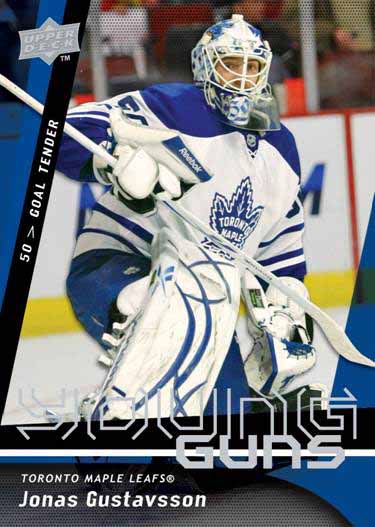Right off the bat, I won't be posting anything on Champs. There simply isn't enough data to determine print run. I might go back to it later to see if I can make some reasonable guesses at the season's end, but for not, its not on the table. Today, instead we'll be dealing with 09-10 SPGU.
For the past three years, the big hist in SPGU have been the manufactured patches featuring names, numbers, nicknames or what have you. This year is no different and since we had the Olympics 'recently', SPGU decided to capitalize by having "Marks of a Nation" (see above). I've always thought of SPGU as the game used equivalent of SP Authentic. For every auto in SPA, there's a jersey or patch card in SPGU. For every auto in SPGU, there's a jersey or patch in SPA.
I'm definitely a bigger fan of the jersey design this year, as opposed to last year, even though they dropped the number of swatches from 2->1. They even managed to get some really nice photos on the basic jersey card, which is a big plus. My only problems with the set are the manufactured patches and the multi patch cards which become a series of little more than tiny head shots. To each their own I suppose.
Before I go into the the break down, I want to point out that ALL of the posted box odds are wrong.
Here's what UD says:
- Avg of two Rookies per box
- 2 Manufactured letter per case
- 1 Auto & 1 GU #ed to 100 or less per box
- Avg of FOUR-FIVE Rookies per box
- ~3-4 Manufactured letter per case
- 1 Auto & 1 GU #ed to 100 or less per box
- Authentic Fabrics are out of ~700
- Base Cards are out of ~1,400
- Opening a 12 box case? 70% on each of these: Extra SIGnificance, Authentic Triples, Legends Classic, Triple Patch, Silver Base & Silver Rookie.
- Any 1/1 card from the set? There's 3 in every 19 cases (12 box case)
- Want a SPGU Eights 1/1 Patch? That's a 1:200 (12 box) case hit!
Some special notes:
- Yzerman & Howe Lettermarks were treated as one normal /50 card.
- Print runs of Authentic Fabric SP are less than specified
- Authentic Fabrics are pulled at about 4 per box
- Base Cards - I can barely find anyone who posts their base cards, but they're about 8 per box as far as I can tell
- SIGnificant Numbers pull ratios are based on an average print run of 30 copies per card
- By the Letter pull ratios are based on an average print run of 6.7
- Marks of a Nation Black/Gold pull ratios are based on an average print run of 5.8
There's more than enough there to help you figure out your own hit ratios. Just take the print run, multiply by the numbering and divide by the # of cases to get your hit ratio. Here's an example to get you started:
Inked Sweaters: 38 different cards with a print run of 50.
38 * 50 = 1900
1900 / 1400 cases = 1.35
So, in every 12 box case, there should be at least one Inked sweaters. Every third case will have a second Inked Sweaters.




